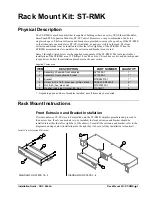
10
Using CoreReLation Phase Analyzer
(In Phase)
Following are examples of
in phase
readings between the Phase Correlation Meter and Goniometer. Again, we
recommend using the Phase Correlation Meter in conjunction with Goniometer for a reliable indication for mono
compatibility.
In Phase (Vertical M Axis)
A quick and simple way to achieve perfect correlation between the left and right channel is to bring
CORE’s
Global Width Knob down to 0.0%, but this collapses the entire mix to mono (summing L & R channels), which is
not ideal when you want certain sounds to sit in different areas of the stereo field (i.e. pads, piano, hi-hats,
background vocals, etc.). A different approach is to make smarter panning decisions on each mix channel,
ensuring you h
ave a balanced stereo mix, verified by CORE’s Phase Correlation Meter and Goniometer.
In Phase (Correlated) -
The “Sweet Spot”.
A well correlated stereo mix will be an ovular shape (tall and narrow) and centered on the vertical M axis. Here
we
’ve achieved a good overall balance between channels. Of course, the shape will vary in width and height at
various points in the mix, but keep in mind the wider and shorter the shape centered on the horizontal S axis, the
more phase issues
you’ll encounter when the mix in summed to mono.
Basic Rule: Limit the number of sounds in the stereo field by keeping core sounds such as the kick, bass,
snare/clap and lead vocals in the center (mono). Use the width knob to decrease the stereo width of excessively
wide sounds to avoid sounds from getting attenuated (quieter) or canceled.


































